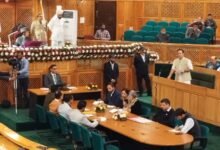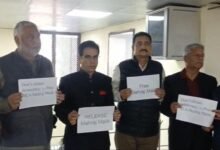Take immediate action or saffron industry in Pampore will disappear by 2030, warn growers

Say lack of irrigation facilities, conversion of land, unavailability of corn main challenges for industry
Jahangeer Ganaie
Srinagar, Nov 15 (KNO): Saffron growers in the Pampore area of south Kashmir’s Pulwama district have raised an urgent call for the government to take immediate steps to prevent the complete collapse of the region’s iconic saffron industry. With production at an all-time low, growers warn that unless critical issues are addressed, there will be no saffron production left in the area by 2030.
Speaking with the news agency—Kashmir News Observer (KNO), several saffron growers said there has been a sharp decline in production this year, which they say has only worsened over the past decade. “This year, the saffron harvest was just 30-40 percent of what it used to be,” said Ashiq Hussain, a saffron grower from the Pampore area. “We’ve been hearing about government schemes and initiatives on paper, but there is no real action on the ground,” he added.
Hussain referred to the establishment of a spice park in Dusoo Pampore and the GI (Geographical Indication) tagging of Kashmiri saffron as examples of initiatives that have failed to reverse the ongoing crisis. “These things look good on paper, but they don’t matter if the saffron doesn’t grow. What’s the point of GI tagging if there’s no saffron to tag?” he asked.
The decline in saffron production, according to farmers, is linked to a range of challenges, with irrigation issues, land conversion, and shortage of saffron corn topping the list. “For the last 15 years, we’ve been hearing about the National Health Mission, but what use is it when we don’t have basic irrigation facilities?” Hussain lamented.
Ghulam Rasool, another grower, said the industry’s decline is accelerating each year. “If the government doesn’t wake up now, we’ll have no saffron industry left,” he warned. Rasool called on authorities to move beyond “blame games” and urgently address the needs of the saffron growers.
Apart from inadequate irrigation, the conversion of saffron land for non-agricultural purposes and the unavailability of saffron corn (the primary seed for cultivation) are also affecting production. Growers said many of them have switched to cultivating mustard or even moved to the horticulture sector as a more reliable alternative. “If this trend continues, we will lose the very essence of saffron cultivation,” said one grower.
The growers are now urging the intervention of Chief Minister Omar Abdullah and Agriculture Minister to formulate and implement effective policies for the revival of the saffron industry. “We need concrete action, not just promises,” they said in a joint statement.
It is important to note that saffron production in Kashmir has already fallen by a staggering 65 percent over the past two decades. The area dedicated to saffron cultivation has shrunk dramatically from 5,707 hectares in 1996-97 to just 2,387 hectares by 2019-2020. This decline is not only a blow to the local economy but also threatens the cultural heritage of Kashmir, where saffron is often referred to as the “golden spice” and holds immense value—(KNO)




